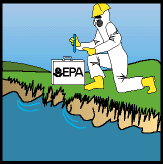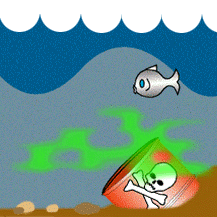| (insert your NIE or newspaper logo here) |
Weekly Online LessonOnline Lesson ArchiveGrade Level: 5-8
|
Superfunds Aren't Super Fun
 The Environmental Protection Agency (EPA) announced a
milestone
achievement on March 17, 2004 -- that the cleanup work at the
nation's
first Superfund site has been completed.
The Environmental Protection Agency (EPA) announced a
milestone
achievement on March 17, 2004 -- that the cleanup work at the
nation's
first Superfund site has been completed.
The site, located in Niagara Falls, N.Y., and referred to as the "Love Canal," took nearly two decades and $400 million to cleanup. The damage this chemical waste dump inflicted upon the health of local residents, animals, and ecosystems is immeasurable.
The dumping of chemical waste here first began in 1920, when the City of Niagara Falls used the canal area as a landfill. Later, the Army used it for disposing of chemical warfare material. Much more dumping occurred during the 1940s and 50s, when the Hooker Chemical Company filled the canal with about 21,000 tons of organic solvents, acids, pesticides, and their by-products.
It wasn't until the 1970s that Love Canal residents really realized how much this history of careless dumping was affecting them. Cancer rates and the number of miscarriages were higher than average, people were getting ill from eating fruits and vegetables grown in their own gardens, and in some areas plants couldn't grow at all.
But the Love Canal was just one example where decades of dumping were making people sick. During this same era, other places -- like towns in New Jersey, Pennsylvania, California, and Tennessee -- were uncovering similar problems.
Finally, in 1980, President Jimmy Carter signed a law called the Comprehensive Environmental Response, Compensation, and Liability Act (CERCLA). Also known as Superfund, this law outlined regulations for disposing of hazardous waste and for cleaning up sites already contaminated.
Over 13,000 Superfund sites across the United States have been identified, and many of them have been cleaned up or are in the process of cleanup. Getting rid of the hazardous waste and the contaminated soil takes a lot of work, time, and money. But the long-term commitment and the hefty price tag are well worth the healthier environment for the people, animals, and plants living in those areas.
So for this week's lesson, you'll learn more about what Superfund sites are, how they become health hazards, and how they get cleaned up. You'll also find out how close you live to Superfund sites and where others exist in your home state.
Superfund Basics
 To
begin, visit the EPA's Superfund
for Kids site, and start with the Introduction
to Superfund. Click Next to move through the
pages.
To
begin, visit the EPA's Superfund
for Kids site, and start with the Introduction
to Superfund. Click Next to move through the
pages.
How are Superfund sites created? What does the EPA do when it finds out about hazardous areas? What role do local communities play in the cleanup process? Who pays for the cleanup?
At the end of the introduction, read about the Chisman Creek Case Study. What exactly prompted local residents to contact state agencies? Why were the area's streams, ponds, and groundwater affected? Who was involved in the cleanup process? What were the final economic, environmental, and social benefits of the project?
Back at the Superfund for Kids home page, jump to the Superfund Stories section. To learn more about the Superfund process, choose the Kids Adventure Story. Click the forward pointing hand on the page to browse through the story panels.
What industrial activities polluted the site? How did the experiment, provided by Ms. Green, demonstrate how the groundwater got contaminated? What does the EPA need to do to make the groundwater safe again, and why is that important?
Read some another Superfund Site Story, the Secret of Bog Creek Farm.
Why do you think the state needed the federal government's help? Why did the soil need to be removed and destroyed? Why was it important to remove the soil before cleaning up the nearby streams and rivers?
 Investigate Your Neighborhood
Investigate Your Neighborhood
Do you have a Superfund site in or near your own neighborhood?
To find out, visit the EPA's main Superfund site, and in the list of Tools choose the Map of NPL sites.
NPL stands for "National Priorities List." Many places may be polluted and threaten the health of an area, but sites on this list have been identified as places that should be investigated by the EPA as soon as possible because the potential health and environmental threats are significant. Here, you can locate NPL sites, check their cleanup progress, and get information on new and proposed NPL sites.
So let's get started by clicking on your home state. How many sites are Proposed, Final, and Deleted?
("Final" means a site has been accepted into the Superfund program. "Deleted" means a site has been taken off the "Final" list, usually because cleanup was completed.)
Click on the Final site closest to where you live. This will jump you down the page to a detailed list showing when the site was initially Proposed and when it was accepted as a Final site. How long did the process to list the site from Proposed to Final?
To learn more about the history of this site, exactly what hazardous materials have been found there, and what the human and ecological risks are, click on the site's name. This will open a detailed PDF about that site in a new browser window.
If you have time, check out all of the Proposed and Final sites listed in your state. Why exactly was each site used as a toxic dumping ground (that is, what type of industry, business, etc. used the property and for what purpose)? Do you notice any pattern in the types of industry that generated the waste or in the specific chemicals that were found there?
Also look at the Deleted sites. How many years did it take to move a site from Proposed, to Final, to Deletion?
Newspaper Activities
Look through issues of Targetnewspaper to find news about a Superfund site or other potentially hazardous area. Why exactly are people concerned about the site? For example, have residents or local officials noticed problems with the water quality or people's health? Why is or why might there be toxic chemicals or other hazardous waste dumped in that area? In what ways are local, state, and federal agencies involved in the process? What exactly has been done so far to address the health and ecological threats posed by the site's condition? Who was, is, or will be responsible for the cleanup costs?
© Copyright 2004
Learners
Online,
Inc.
